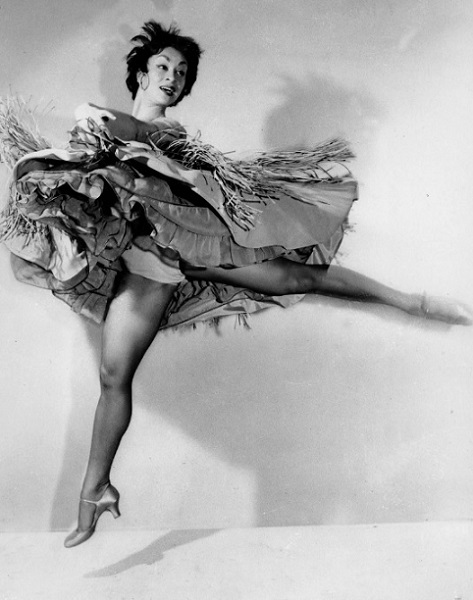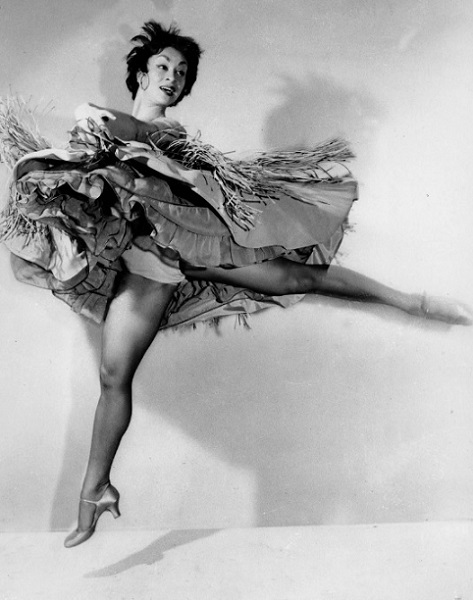
Robert D. McFadden (The New York Times) reported the death of Chita Rivera, and a career that spanned nearly six decades, during which “she dazzled audiences [. . .] most memorably starring as Anita in West Side Story and Velma Kelly in Chicago. Many will remember her as a fearless woman who embraced her Puerto Rican heritage and led the way for others. In a 2017 interview with Margaret Gray (Los Angeles Times), she stated, “Diversity is vital. Women’s rights are vital. You can’t sit back. You have to speak up and speak out.” Her legacy will live on.
Chita Rivera, the fire-and-ice dancer, singer and actress who leapt to stardom in the original Broadway production of “West Side Story” and dazzled audiences for nearly seven decades as a Puerto Rican lodestar of the American musical theater, died on Tuesday in New York. She was 91. [. . .]
To generations of musical aficionados, Ms. Rivera was a whirling, bounding, high-kicking elemental force of the dance; a seductive singer of smoky ballads and sizzling jazz; and a propulsive actress of vaudevillian energy. She appeared in scores of stage productions in New York and London, logged 100,000 miles on cabaret tours and performed in dozens of films and television programs.
On Broadway, she created a string of memorably hard-edged women — Anita in “West Side Story” (1957), Rosie in “Bye Bye Birdie” (1960), the murderous floozy Velma Kelly in “Chicago” (1975) and the title role in “Kiss of the Spider Woman” (1993). She sang enduring numbers in those roles: “America” in “West Side Story,” “One Boy” and “Spanish Rose” in “Bye Bye Birdie,” and “All That Jazz” in “Chicago.”
Critics thumbed thesauruses for hyperboles to rhapsodize about her pyrotechnics. In 2005, Newsweek called her “only the greatest musical-theater dancer ever.” Reviewing her performance in “Bye Bye Birdie” in The New York Times, Brooks Atkinson called her “a flammable singer and gyroscopic dancer.” Of her Tony Award-winning romp as Anna in “The Rink” (1984), Richard Corliss in Time magazine wrote: “Packing 30 years of Broadway savvy into the frame of a vivacious teenager, the 51-year-old entertainer could by now sell a song to the deaf.”
Ms. Rivera was a hard-working perfectionist who rarely missed a beat, let alone a performance. Trained in classical ballet before joining the musical stage, she was beloved on Broadway, where she began performing in the early 1950s. With her showstopping voice and eloquent body language, she radiated a charisma rooted in solid song and dance techniques and in the pleasures she derived from them.
As a singer and actress, Ms. Rivera was largely self-taught, though she received an on-the-job education from some of the foremost pedagogues in the pantheon: the choreographers Bob Fosse and Jerome Robbins, the composer Leonard Bernstein, the songwriting team of John Kander and Fred Ebb, and the playwright Terrence McNally.
In 1986, Ms. Rivera had to suspend her dancing life when a taxi collided with her car in Manhattan, shattering her left leg in a dozen places. She underwent two surgeries, with screws and plates used to reconnect her bones, followed by months of rehabilitation. For many dancers, the injuries might have been career-ending, but almost a year after the accident she began dancing again, easing her way back with cabaret acts that sustained her for years. [. . .]
In “Chita Rivera: The Dancer’s Life,” an autobiographical retrospective presented on Broadway in 2005, she delivered a tango about the men in her past, a dance sequence for Mr. Fosse, Mr. Robbins and other choreographers, and a medley of her musical highlights, including “A Boy Like That” from “West Side Story” and “All That Jazz” from “Chicago.”
“At 72, she still has the voice, the attitude and — oh, yes — the legs to magnetize all eyes in an audience,” Ben Brantley wrote in a review for The Times. “She is a pro’s pro in a world of exacting judgments and mythic standards. It feels right that ‘The Dancer’s Life’ should present her as the ultimate gypsy made good, the talented trouper who got the right breaks.”
A decade later, Ms. Rivera was still a headliner, starring in a 2015 musical adaptation of “The Visit,” the Kander-Ebb-McNally musical based on Friedrich Dürrenmatt’s satirical play about greed and revenge. In it she played a wealthy widow who returns to her depressed hometown with an offer of money for the murder of an old flame who betrayed her long ago.
The production ran on Broadway for 11 weeks, including previews, grossed $2 million and received five Tony nominations. The Times reported that “the opening night audience was on its feet, its applause so boisterous and sustained that Ms. Rivera had to wave it down with a magisterial sweep of her hand.”
Ms. Rivera was showered with honors during her long career. She won two Tony Awards for best actress in a musical, for “The Rink” and “Kiss of the Spider Woman”; was nominated for eight others; and in 2018 received a special Tony for lifetime achievement. In 2002, she became the first Hispanic American woman to receive Kennedy Center Honors, the capital’s version of the Oscars, in a group that included Elizabeth Taylor, James Earl Jones and Paul Simon.
In 2009, she received the Presidential Medal of Freedom, the nation’s highest civilian honor, from President Barack Obama in a White House ceremony.
It was the culmination of an odyssey that began a few miles away in Washington on Jan. 23, 1933, with the birth of Dolores Conchita Figueroa del Rivero, the third of five children of Pedro Julio and Katherine (Anderson) del Rivero.
Her father, who was born in Puerto Rico, played the clarinet and saxophone with the U.S. Navy Band and the Harry James Orchestra. He died when Conchita was 7. Her mother, who was of Scottish, Irish and Puerto Rican descent and also had African American ancestors, which she discovered late in life, became a clerk at the Pentagon and enrolled Conchita in singing, dance and piano lessons. Dancing became her passion. On the advice of her teacher, she auditioned for George Balanchine and won a scholarship to his School of American Ballet in New York City. [. . .]
Ms. Rivera shot to stardom in 1957 as Anita in “West Side Story,” the Romeo-and-Juliet tale set in postwar Manhattan, where star-crossed lovers, Maria and Tony, are caught in a deadly war of street gangs. As Anita, she sang a poignant duet with Carol Lawrence as Maria, “A Boy Like That/I Have a Love,” and a magical “Tonight,” as well as leading a rousing ensemble in “America.” [. . .]
For full article, see https://www.nytimes.com/2024/01/30/theater/chita-rivera-dead.html
Also see https://www.cbsnews.com/news/chita-rivera-dies-at-91/, https://people.com/chita-rivera-dead-at-91-broadway-star-7971697 and https://elpais.com/cultura/2024-01-30/muere-chita-rivera-pionera-de-broadway-y-la-primera-anita-en-west-side-story-a-los-91-anos.html
[Photo above from AP: Chita Rivera, an original cast member in the Broadway production of “West Side Story,” was a hard-working perfectionist who rarely missed a beat, let alone a performance.]
Robert D. McFadden (The New York Times) reported the death of Chita Rivera, and a career that spanned nearly six decades, during which “she dazzled audiences [. . .] most memorably starring as Anita in West Side Story and Velma Kelly in Chicago. Many will remember her as a fearless woman who embraced her Puerto






